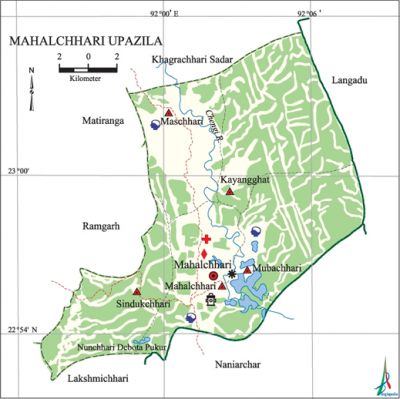Mahalchhari Upazila
Mahalchhari Upazila (khagrachhari district) area 251.22 sq km, located in between 22°52' and 23°03' north latitudes and in between 91°56' and 92°00' east longitudes. It is bounded by khagrachhari sadar upazila on the north, naniarchar and lakshmichhari upazilas on the south, langadu and Naniarchar upazilas on the east, matiranga and ramgarh upazilas on the west.
Population Total 50757; male 26359, female 24398; Muslim 13662, Hindu 5348, Buddhist 31465, Christian 230 and others 52.
Water bodies' Chengi River and Nunchhari Debota Pukur are notable.
Administration Mahalchhari Thana, now an upazila, was formed in 1906.
| Upazila | ||||||||
| Municipality | Union | Mouza | Village | Population | Density (per sq km) | Literacy rate (%) | ||
| Urban | Rural | Urban | Rural | |||||
| - | 5 | 13 | 196 | 10249 | 40508 | 202 | 61.7 | 39.9 |
| Upazila Town | ||||||||
|
Area (sq km) |
Mouza |
Population |
Density (per sq km) |
Literacy rate (%) | ||||
| 23.31 | 1 | 10249 | 440 | 61.7 | ||||
| Union | ||||
| Name of union and GO code | Area (acre) | Population | Literacy rate (%) | |
| Male | Female | |||
| Kayangghat 15 | 12800 | 4095 | 3846 | 41.9 |
| Mahalchhari 31 | 10880 | 8647 | 7700 | 52.7 |
| Maschhari 47 | 9600 | 5697 | 5503 | 43.2 |
| Mubachhari 63 | 12160 | 3561 | 3378 | 48.0 |
| Sindukchhari 79 | 16000 | 4359 | 3971 | 28.0 |
Source Bangladesh Population Census 2011, Bangladesh Bureau of Statistics.
Archaeological heritage and relics Mahalchhari Thana Bhaban, Chengi Bridge, Chitta Mandir, Nunchhari Devata Pukur (pond).
War of Liberation On 25 April 1971, about 45 freedom fighters including Major Mir Shawkat Ali and Captain Aftabul Kader of East Bengal regiment took position at Mahalchhari hilly area. On 26 April an encounter was held between the freedom fighters and the secessionist Mizos in which 15 freedom fighters including Captain Kader were killed.
For details: see মহালছড়ি উপজেলা, বাংলাদেশ মুক্তিযুদ্ধ জ্ঞানকোষ (Encyclopedia of Bangladesh War of Liberation), বাংলাদেশ এশিয়াটিক সোসাইটি, ঢাকা ২০২০, খণ্ড ৭।

Religious institutions Mosque 28, temple 7, Buddhist vihara 58.
Literacy rate and educational institutions Average literacy 44.4%; male 50.9%, female 37.4%. Educational institutions: college 1, secondary school 5, primary school 52, satellite school 12, community school 3, madrasa 1.
Cultural organisations Library 1, press club 1, stadium 1, town hall 1, cinema hall 2, playground 23.
Main sources of income Agriculture 66.75%, non-agricultural labourer 6.68%, industry 0.42%, commerce 9.95%, transport and communication 3.35%, service 8.88%, construction 0.52%, religious service 0.09%, rent and remittance 0.07% and others 6.4%.
Ownership of agricultural land Landowner 51.35%, landless 48.65%; agricultural landowner: urban 33.27% and rural 56.6%.'
Main crops Paddy, turmeric, potato, pumpkin, ginger, hilly arum.
Extinct or nearly extinct crops Apple, kaju nut, cotton.
Main fruits Mango, jackfruit, pineapple, litchi, papaya, lemon, orange, wood apple.
Communication facilities Pucca road 43 km, semi-pucca road 32 km, mud road 220 km; waterway 36 km.
Extinct or nearly extinct traditional transport Palanquin, horse carriage, bullock cart.
Noted manufactories Saw mill, rice mill, ice factory.
Cottage industries Goldsmith, weaving, wood work.
Hats, bazars and fairs Hats and bazars are 3, fairs 2, most noted of which are Mahalchhari Bazar, Debalchhari Bazar and Maschhari Bazar.
Main exports Turmeric, jackfruit, pineapple.
Access to electricity All the unions of the upazila are under rural electrification net-work. However 28.1% of the dwelling households have access to electricity.
Sources of drinking water Tube-well 64.7%, tap 0.9% and others 34.4%.
Sanitation 33.5% of dwelling households of the upazila use sanitary latrines and 60.0% of dwelling households use non-sanitary latrines; 6.5% of households do not have latrine facilities.
Health centres Upazila health centre 1, family planning centre 3, homeopathic treatment centre 5.
NGO activities Operationally important NGOs are brac, proshika. [Mongchen Ching]
References Bangladesh Population Census 2001 and 2011, Bangladesh Bureau of Statistics; Cultural survey report of Mahalchhari Upazila 2007.
